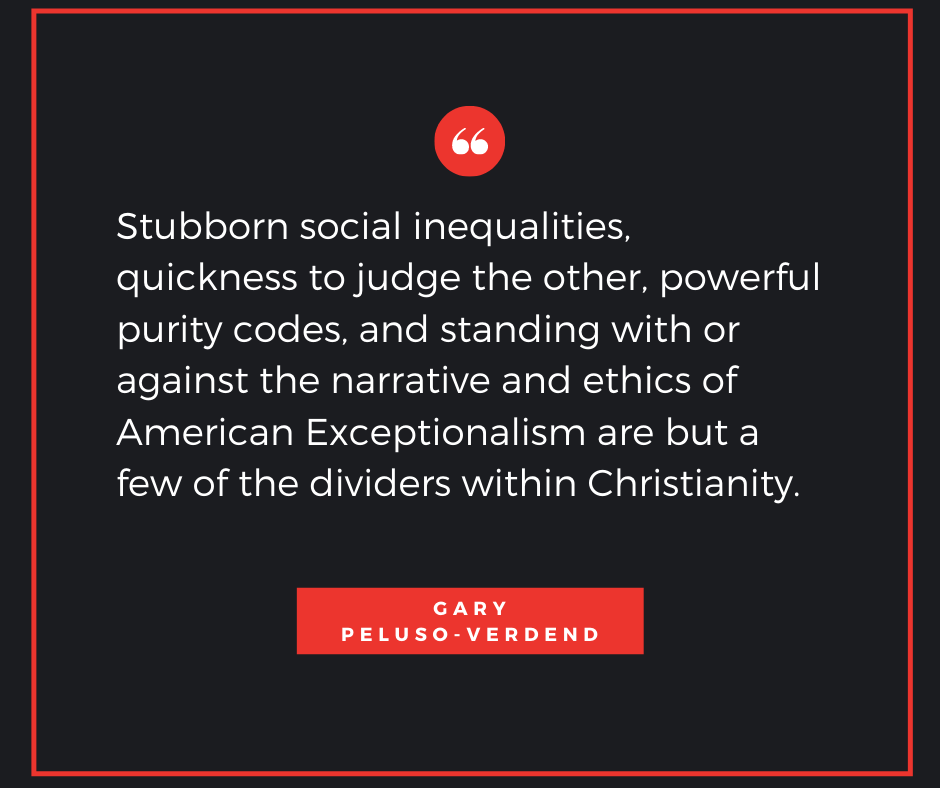If We Want Healing, Commit to Struggling Together
Forty-five years ago this month, theologian and ecumenist Robert McAfee Brown gave a brilliant speech at the opening of the World Council of Churches Assembly in Nairobi, Kenya. His address was a tuning fork for the Assembly. I recently reread the speech and an article published a year before on the same topic. Both the article and the speech shed light on today’s struggles in churches and society. At a time when the call from one side or the other is for “healing” and “unity,” Brown’s words are instructive—and a should give us pause.
The Nairobi Assembly theme was “Jesus Christ Frees and Unites.” Brown entitled his article: “Jesus Christ Frees and Unites… and Divides.” It is Brown’s inclusion of Jesus the Divider, and the connection between freedom, division, and unity that catches my attention as I reflect on our current day.
At Nairobi in 1975, half the delegates were from the Two-Thirds World; the European and North American brands of Christianity were losing their dominance. The carnage of the Vietnam War and the political and social fallout in the non-Western world were fresh. The arms race between the Soviet Union and the U.S. was surging. The gap between the Haves and Haves Not in the world was glaring. Much of the world was unhappy with the U.S.
Brown, by his own description of being an educated affluent white male from the U.S., looked at the happy-happy theme of “Jesus Christ Frees and Unites.” He judged his speech would be dismissed as the Oppressing Gospel of the Privileged if he did not also address humankind’s deepest divisions, and particularly his nation’s role in those divisions. So, he decided to speak using this sequence: Jesus Christ frees, Jesus Christ divides, Jesus Christ unites.
The inclusion of Jesus the Divider means that, if we really want to get to reconciliation, healing, and unity, the path is hard. Jesus the Divider means there is going to be struggle, tension, conflict, and discomforting the comfortable. Then and only then are “Christian freedom” and “Christian unity” going to be meaningful to the majority of the world’s Christians.
How does Jesus Christ divide? Brown wrote:
…He divides me from many of my fellow Christians. Where some of them want a Christ who will not stir up trouble, I want a Christ who will challenge the status quo. Conversely, when I confront other Christians who want a revolutionary Christ, I discover that my own talk of ‘revolution’ is usually little more than the rhetoric of a middle-class churchman, and I am likely to feel threatened by Third-World talk of the political and economic ‘liberation’ that is an absolute necessity to Christians less advantageously placed than myself. As a result, Jesus Christ easily becomes a cause of division between American white Christians and Latin American or Asian or black North American Christians. (431)
Brown argues that the freedom Jesus Christ offers must lead to first to a period of division. The forces that keep persons and peoples in bondage must be exposed and faced for what they are. Unity without the period of division—without the exposure of the systems and powers of bondage, without the struggle, and without change—is not Gospel unity.
Brown cautions against facile “All Lives Matter” and “Everyone is Oppressed” sort of claims:
…when [the response “everyone is oppressed”] is made too quickly, it defuses and demeans and denies the revolutionary messages of the Gospel. If I can immediately be assured that I too am oppressed and that the message therefore is addressed directly to me, then I can conveniently escape responsibility for the degree to which I do serve in Pharaoh’s court, and I can continue to be an instrument of oppression against “the wretched of the earth.” (436)
Before concluding, Brown reflected on the concluding commitments of previous Assemblies, such as “We intend to stay together” or “We intend to grow together.” He opined that the Nairobi delegates should consider the commitment, “We intend to struggle together.”
Please sit with that statement for a minute. “We intend to struggle together.”
Brown held out hope for unity after a time of division, based on the uniting power of Jesus Christ that transcends all human-made divisions. But, how long will it take for a church, for a society, to move from division to reconciliation?
I am trying to see with eyes of faith and trust, but the realities of polarization and fragmentation and “flocking of like with like” are so powerful and evident. I have been involved in Christian ecumenical ventures since I was a college sophomore and visited ecumenical centers of Western Europe.
While in seminary, I took courses at schools of other Christian traditions. When I was a pastor, I participated in ecumenical clergy associations. I wrote a PhD dissertation at Chicago on the ecumenical movement and the nature of the community we seek. I researched local ecumenical and interreligious organizations in the U.S. for the Lilly Endowment.
 But during all these years, the divide in the world and in the U.S. between those with and those without has grown. Inequality threatens democracy and diminishes the promise of liberty and justice for all. Stubborn social inequalities, quickness to judge the other, powerful purity codes, and standing with or against the narrative and ethics of American Exceptionalism are but a few of the dividers within Christianity.
But during all these years, the divide in the world and in the U.S. between those with and those without has grown. Inequality threatens democracy and diminishes the promise of liberty and justice for all. Stubborn social inequalities, quickness to judge the other, powerful purity codes, and standing with or against the narrative and ethics of American Exceptionalism are but a few of the dividers within Christianity.
Now take the same perspectives, look to the U.S., and multiply the power of those dividers.
Before there can be healing in church or society, we ecumenically-oriented Christians know this much: there will be no “beloved community” or simply a tolerant society, held together by the tension between freedom and equality, without courageously and humbly struggling together to reckon with our past, seeing the present clearly, imagining a future on the other side, and then walking together into the change.
References:
Brown, Robert McAfee. 1974. “Jesus Christ frees and unites . . . and divides.” The Ecumenical Review 26, no. 3: 430-438. ATLA Religion Database with ATLASerials, EBSCOhost (accessed September 17, 2015).
Brown, Robert McAfee. 1976. “Who is this Jesus Christ who frees and unites.” Mid-Stream 15, no. 2: 129-145. ATLA Religion Database with ATLASerials, EBSCOhost (accessed September 17, 2015).
Dr. Gary Peluso-Verdend is president emeritus at Phillips Theological Seminary and is the executive director of the seminary’s Center for Religion in Public Life. The opinions expressed in this blog are those of the author. Learn more about the Center’s work here and about Gary here. You can watch the 5 sessions and 4 interviews Gary created for the online class, Regenerating the Spirit of Democracy, on the seminary’s YouTube page.


Comments are closed.